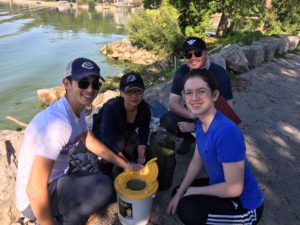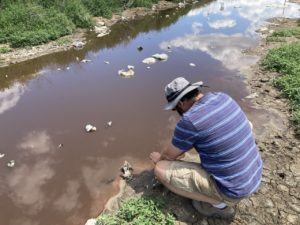At the Laurier Institute for Water Science (LIWS), hydrologists work with toxicologists. Climatologists team up with ecologists. Biochemists strategize with public policy experts.
Founded in 2008, the institute combines expertise found within a variety of Wilfrid Laurier University departments with the strengths of strategic external partners — including governments, environmental organizations and Indigenous communities.
Together, they’re tackling everything from transboundary water policies to the impacts of climate change on Arctic lakes.
“Important problems by definition require multidisciplinary approaches,” says James McGeer, a biologist and associate director of LIWS. “Collaborations are essential for success.”
Helping fish breathe easier
It’s a philosophy that’s attracting early-career researchers like Erin Leonard. “Collaborations are the cornerstone to building my research program,” says the environmental toxicologist, who examines how human activity affects the creatures in freshwater systems.
“Looking at water quality without species diversity is a mistake,” she says. It’s a synergistic system, she explains, and losing even a few species affects water quality drastically.
Before joining LIWS in 2021, Leonard studied the impacts of Kitchener’s wastewater treatment plants on freshwater mussels in the Grand River. And in Hamilton Harbour, she examined how riprap — rubble and boulders used to stabilize shorelines — contributed to the rise of invasive species like the round goby.
Today, she focuses on the one-two punch of climate change and metal contamination. Warming temperatures reduce the levels of oxygen in fresh water, forcing fish to work harder to breathe. Metal contaminants can make things even worse by inhibiting fish’s ability to adapt to changes in environmental oxygen.
Those metals don’t just come from mining effluent. Leonard points to copper commonly found in boat paints and the more than 400 tonnes of lead sinkers and jibs that recreational fishers in Canada lose every year.
She and McGeer are also investigating the potential impacts of rare earth metals. There is a growing concern about possible impacts in the environment, thanks to an explosion in their use for things like electric vehicle batteries, computers and catalytic converters. She’s collaborating with other Ontario Water Consortium (OWC) members about the potential to extract rare earth metals in biosolids created by wastewater treatment plants.
By quantifying harmful levels of contaminants and understanding their impact, Leonard aims to inform the regulations governing drinking water and the ecosystems that provide it.
“It’s really important that we make our decisions based on knowledge,” she says. “Canada is lucky to have so much access to fresh water. Protecting these resources is essential.”
Northern exposure
Fellow LIWS member Heidi Swanson is also looking at climate change impacts and metal contamination in fish, but her work takes her further north.
In her role as the inaugural Jarislowsky Chair in Sustainable Water Futures, she’s dividing her time between Laurier’s campus in Waterloo and the research office it has established in Yellowknife as part of the university’s longstanding partnership with the Government of Northwest Territories.
Swanson leads an interdisciplinary program focused on how climate change is affecting aquatic ecosystems — and that means taking lots of perspectives into account.
“Water connects everything and everyone,” she says. “Communities have needs, industry has needs, governments are in a regulatory role, and clean, healthy waters are essential to the cultural, spiritual, and physical well-being of global peoples. When tackling complex issues surrounding water, we as academics can work to find common ground that is centered in our collective need and apply foundational research in a way that has a positive outcome for as many as possible.”
Her team is exploring why mercury levels vary so much between fish from different lakes. She’s also examining recent changes in abundance in fish populations like Arctic char — a staple food through most of Nunavut — using acoustic telemetry and reconstructing migration histories.
Swanson is no stranger to this part of the country. Her experience in the North stretches back to high school, when she spent a summer working as a field technician for a diamond mine. That means she’s very familiar with the challenges — whether it’s figuring out cargo payloads for helicopters or losing her gear in the Hay River floods earlier this year.
Despite the logistical “goat rodeo,” Swanson loves working in Northern communities. “The landscape is amazing. The people are more amazing,” she says. “I’m so very grateful.”
Forging crucial connections
McGeer gives a lot of credit to Laurier for supporting water science and investing in LIWS. “It’s been pretty amazing to have that level of institutional support,” he says.
He also offers kudos to the OWC for extending the Institute’s synergies even further. “[OWC] builds connections,” he says. “It’s not only multidisciplinary and across sectors, it’s also across these research institutions.”
Today, those connections are contributing to Laurier-made insights everywhere from the Grand River in southern Ontario to Great Slave Lake and beyond.


